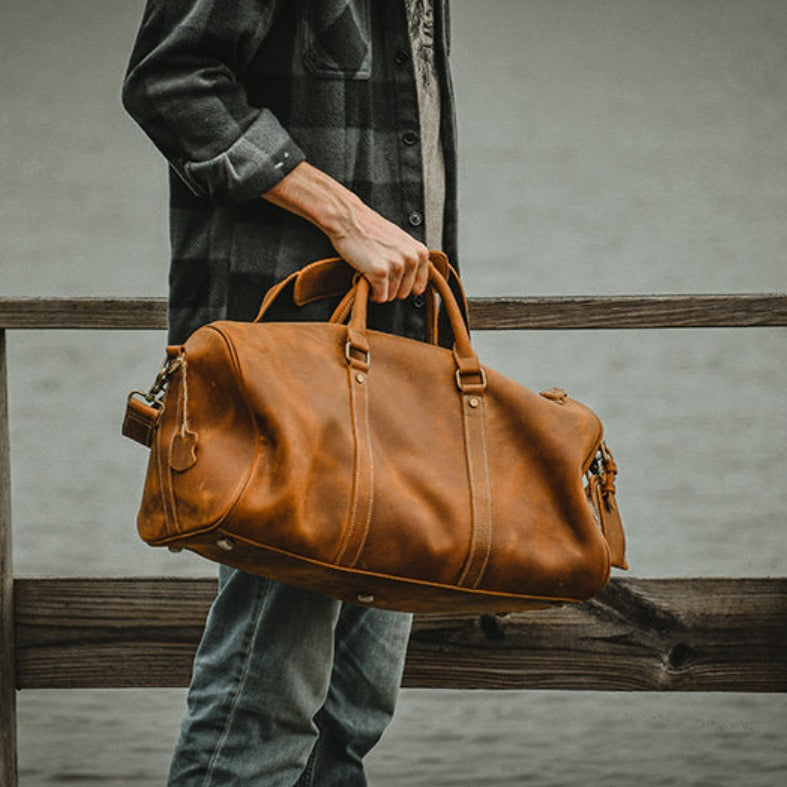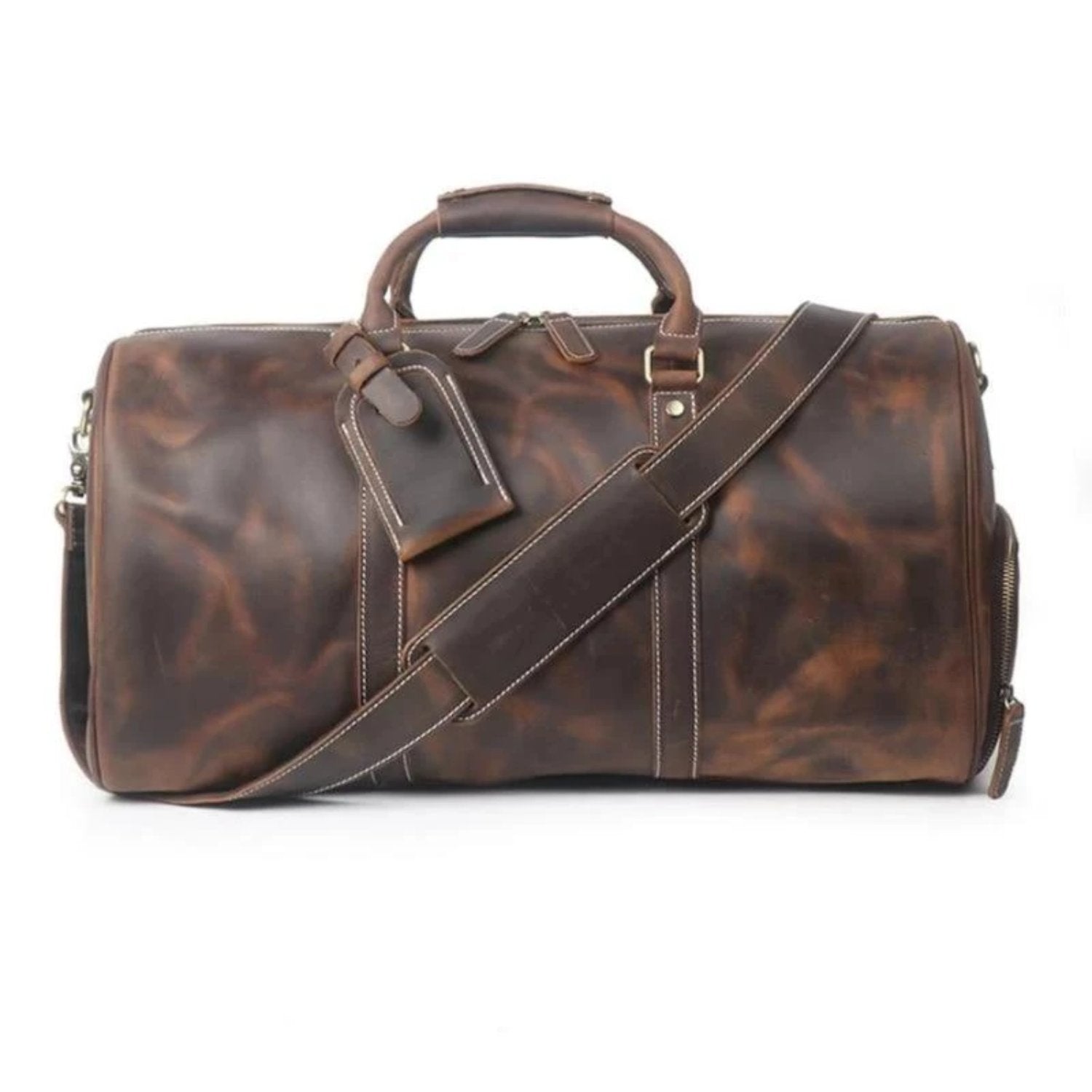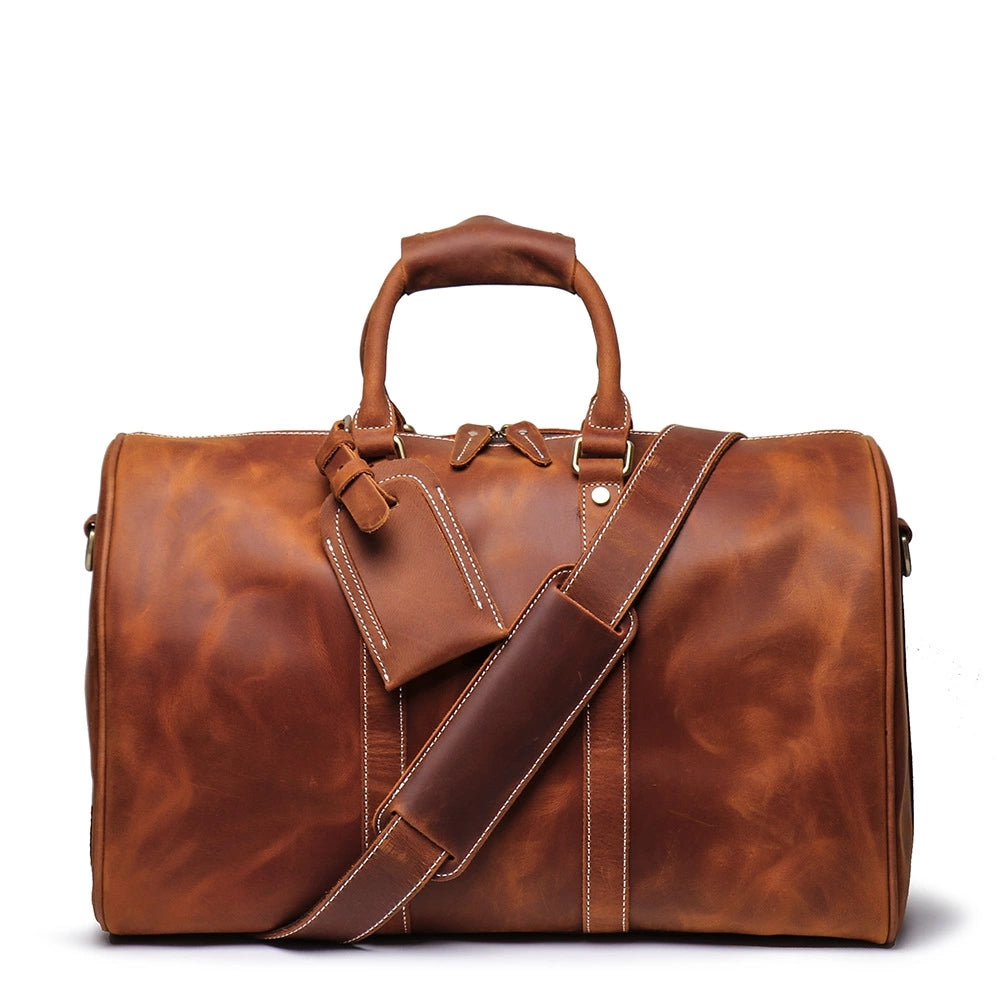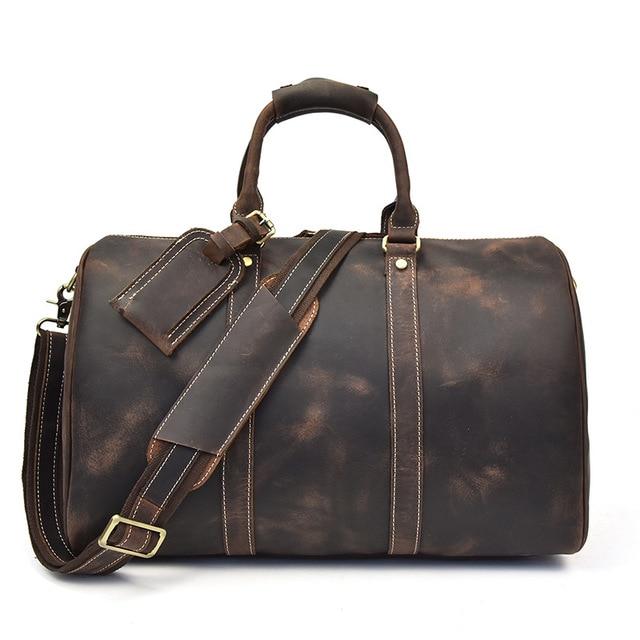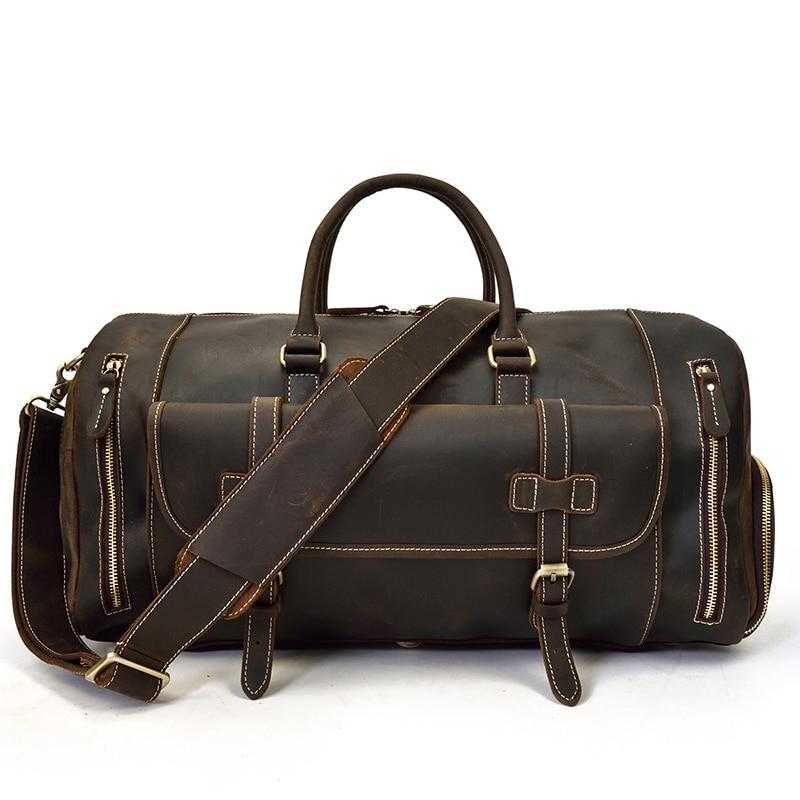Is it possible to repair cracked leather? It's one of the most frequently asked questions we get as leather experts. The response is dependent on the type of damage, but restoration will always work wonders. Of course, nothing beats the charm or sophistication of genuine leather – and the last thing you want to see is your prized bag or briefcase steadily losing its luster.
Key Takeaways
- Understanding the science of leather composition is crucial for proper care and maintenance
- Regular conditioning is essential for preventing leather cracks and maintaining leather quality
- Different types of cracks require different repair approaches - from simple conditioning to complex filling and dying
- Prevention through proper storage and maintenance is more effective than repairs
- Professional help should be considered for valuable items or severe damage
The Science Behind Leather Cracking
Before we get into how to repair cracked leather, it's important to understand some of the science behind the skin. Leather, like any natural material, can become worn and degraded over time. It is, by definition, animal skin, which can dry out and crack.
When leather splits, it is due to microscopic changes in the material: leather is made up of countless tiny interwoven fibres packed tightly together, with denser connected fibres near the surface and looser connected fibres further in. These fibers will eventually dry out, causing chafing and a worn appearance.
Research has shown that leather's remarkable durability and strength come from its fibrous protein structure, particularly collagen, which creates this tightly interwoven network of fibers. This structural composition is fundamental to understanding how to properly care for and maintain leather products (Boahin et al., 2011).
Throughout the animal's life, the skin is kept nourished with replenishing natural oils. When an animal skin is turned into leather, tanning agents replace the water in the skin's protein. Depending on the type of leather, lubricating oils and waxes may be used to maintain flexibility. Vegetable-tanned leathers, especially Italian leathers, are among the best-lubricated leathers available.
If you have dry skin, you are aware that a lack of water and oils in the skin's upper layers will result in rough and dry patches. Leather is no exception. Similarly, if you fail to moisturize your skin for an extended period of time, your skin will suffer more damage. As the leather flexes and moves, the packed fibers can constantly rub against one another due to moisture loss. These fibres eventually become rigid and tight, creating cracks at the stress points.
Common Causes of Leather Damage
Cracks in leather are common when it dries out or is exposed to sunlight. The leather fibers abrade one another. Although the damage is irreversible, several cracks can be easily concealed by rehydrating the leather with a quality conditioner. Deeper cracks must be filled in or dyed to fit in with the leather's coloring. A valuable piece of leather can be revitalized with due care.
In our experience developing The Hagen Backpack, we encountered various challenges with crazy horse leather, which naturally develops a unique patina over time. This premium cowhide leather is particularly susceptible to showing natural creases and lines, which actually enhance its antique appearance. During our quality control process, we learned to distinguish between these desirable characteristic marks and actual damage that requires intervention.
Initial Preparations Before Repairing Cracked Leather

Before diving into the cracked leather repair process, it's crucial to ensure that you start with the right preparations. Begin by assessing the extent of the damage—identify any deep cracks, scuffs, or general wear that may require attention. It's also important to clean the leather thoroughly with a gentle leather cleaner to remove dirt and oils that could interfere with the repair products.
Next, consider the environment in which you’ll be working; a well-lit area is preferable, as it allows for better visibility of the damaged spots. Additionally, gather all necessary tools and materials beforehand—this typically includes a leather conditioner, filler compounds, and a soft cloth. Taking these steps not only streamlines the repair process but also increases the chances of achieving a seamless and professional finish.
Repairing Cracked Leather
Cracks are permanent by definition, since the fibres – the very structure of the leather – have been destroyed. But it's not just bad news. The good news is that many cracks are easy to conceal – and the repair can be done quickly – by using leather conditioners to reinforce the fibers around the cracked leather.
Fixing Light Leather Cracks
The first port of call should always be a good conditioner that not only strengthens the fibres covering the cracks, but also aids in the blend of the scar with the rest of the leather. On cracked leather, the results can be amazing – a scratch or light crack can be smoothed away and made to appear like a normal imperfection.
Step-by-Step Process for Light Cracks
- Clean your leather: To remove any dirt or dust, use a smooth, dry brush or cloth to clean the surface of the cracks and surrounding leather. Then, using a shoe dauber (or any tiny, fine-bristled brush), apply leather cleaner or saddle soap to the leather cracks, thoroughly cleaning them. Saddle soap contains mild soap and softeners, and after cleaning the broken leather surface, it should be soft and flexible enough to proceed to the next level.
- Smoothe it: For this stage, you can use a cracked leather repair compound, but we suggest dabbing the cracking areas with mink oil or neatsfoot oil. Smooth the oil into and over the cracks with gentle pressure. This can be done with a cloth or even the back of a spoon. Continue to apply to the broken surface until the cracks become less visible. Wipe away any excess oil with a soft rag. (First, spot test the oil in an inconspicuous place to see whether it has any impact on the color of the leather.)
- Repeat: You may be satisfied with the softer look and texture of the cracking areas at this stage, but don't forget to apply a leather conditioner to the treated surface area as well as the surrounding leather surface with a soft cloth. To maintain the leather bag in good shape and avoid further drying and cracking, apply conditioner to the entire bag once a month.
It is much easier to read on how to patch cracked leather than it is to do it. Please test any cleaner, repair compound, oils, or conditioner you want to use on a small area first. And congratulations on your efforts to get the cracked leather back to life.
Repairing Deep Leather Cracks
| Method | Step | Tool / Tip |
|---|---|---|
| 🩹 Filler | 1. Clean | Leather soap + damp cloth |
| 2. Dry | Overnight, no sun/heat | |
| 3. Sand | Super-fine grit, gentle | |
| 4. Fill | Palette knife → press in | |
| 5. Scrape | Remove excess | |
| 6. Cure | 6 hrs, repeat if shrinks | |
| 🎨 Dye Blend | 1. Fill (optional) | From Method 1 |
| 2. Sand | Ultra-fine, along grain | |
| 3. Dye | Sponge, thin coat in crack | |
| 4. Dry | Hairdryer low, 2 mins | |
| 5. Repeat | Up to 5x, blend edges | |
| 6. Seal | Leather sealer + dryer |
PH Tip: Dry in shade with fan (avoid direct sun). Best for: Bags, wallets, seats with deep cracks.
If your leather is porous and has deep cracks, using a conditioner is unlikely to help because the conditioner would simply soak into the leather. But all is not lost; with a little more elbow grease, to repair cracked leather and restore it to its former glory.
Method 1: Using Filler to Repair Leather Cracks
Step-by-Step Process:
- Clean: Wash some dirt away with a cloth or sponge and soap or leather cleaner. Again, test the cleaner on a small area first, then blend any soap with water first.
- Wait overnight for the leather to dry completely: If there is some moisture on the leather, the filler will not settle into the cracks. Wipe away any excess moisture with a dry cloth to ensure that it dries quickly.
- Smooth: Smooth out the cracks with a piece of super-fine sandpaper, using gentle pressure as you go. Stop when you have a smooth-to-the-touch finish. Then, using a dry rag, clean away any dust. Avoid using harsher, coarser sandpaper because it can leave marks.
- Apply leather filler: With a palette knife, spread the filler over the holes, then brush in the paste to fill in the gap. More should be applied before the crack appears to be filled.
- Remove the excess paste with the knife: Scrape off the excess paste with the palette knife's edge tipped sideways. Continue doing so until no more overspill is visible.
- Let the leather dry for six hours: This ensures that the filler sets and solidifies. A well-ventilated space or the open air can aid in the drying of the leather. However, avoid direct sunlight and keep the leather away from direct heat, as these factors will dry out the material and cause additional cracks. As the filler dries, it can shrink, necessitating another coat.
Method 2: Blending Cracks with Leather Dye
A dye may be used to repair cracked leather, but a mixture of a leather filler and dye works better for deep cracks. If the interior of a crack is lighter in color than the outside, a dye is your best bet.
Step-by-Step Process:
- Prepare the surface with filler: If required, repeat the steps above to add leather filler. Allow the treatment to dry.
- Sand and smooth: To prepare the surface for the dye, sand the leather with ultra-fine sandpaper and wipe it clean. Gently brush along the grain of the leather until it is smooth to the touch. Wipe away any dirt and dust, as these can interfere with the color's absorption.
- Apply the dye: Select a leather dye that closely matches the color of your piece. Using a color-fast sponge or applicator pad, apply a thin coat of the dye to the cracks. Rub the cracks to ensure that the dye is evenly distributed.
- Let it dry: Allow the dye to dry for two minutes with a hairdryer set on low, moving the dryer back and forth around the cracks to keep the leather from drying out.
- Blend the cracks: If necessary, blend the cracks with many coats of dye. Up to five treatments can be needed depending on the severity of the crack. Dab the dye directly into the crack with each treatment, then rub the surrounding area to mix it together. Each time, use a hairdryer to dry the dye.
- Seal the deal: Using a leather sealer to treat the cracks helps to preserve and condition the dye. Spray the sealer directly onto a sponge and rub it into the infected region, covering the dye with a second coat if necessary. This should help to keep stains and more damage at bay. Cure the sealant with a hairdryer for two minutes, moving the dryer back and forth across the crack.
Prevention and Maintenance
In a nutshell, avoidance is the best method of treatment. When you receive your object, keep it away from direct heat and sunlight, and avoid storing it in excessively dry areas. Investing in a quality conditioner is important for leather treatment, as it prevents the skin from drying out and cracking.
Studies confirm that preventative measures are significantly more effective than repairs when it comes to leather maintenance. Keeping leather away from direct sunlight and heat sources, combined with regular moisturizing, is critical for maintaining the material's integrity and avoiding irreversible damage (Cesare et al., 2018).
Tips for Leather Care
- Apply a leather conditioner every 3 months to keep the leather from cracking. Leather cracks when it dries, so a good conditioner can keep the majority of the damage at bay.
- Keep leather away from direct sunlight and heat sources. Heat causes leather to dry out, which causes cracks. If your leather pieces seem to crack often, it may be due to heat exposure.
- Seal rips and tears with leather glue. Simply spread the glue and press the torn piece down to secure it. The tear can then be blended in with filler or dye.
- To fix faux leather, use leather dye or paint.
- Consider taking your leather product to a specialist if it is expensive or heavily damaged. Professionals may make substantial repairs or even reupholster pieces to keep them in good condition.
Rehydrating Leather as a Method to Repair
Rehydrating leather is a crucial step in the cracked leather repair process, aimed at restoring the material’s natural oils and flexibility. Over time, leather can become dry and brittle, leading to unsightly cracks. By using a high-quality leather conditioner or moisturizer, you can deeply penetrate the leather fibers, allowing them to regain their suppleness. It's essential to apply the conditioner evenly, focusing on the areas with visible damage.
Let the product absorb thoroughly before wiping off any excess, as this will ensure optimal hydration without leaving a greasy residue. Regular rehydration not only aids in immediate repairs but also extends the lifespan of your leather goods, preventing future cracks and preserving their beauty.
Professional Versus DIY Leather Repair
When it comes to leather repair and the beauty of leather, the choice between professional services and a DIY approach often depends on the type and extent of the damage. Whether dealing with cracked leather, leather car seats, or other leather items, professional leather repair specialists bring years of expertise, specialized tools like a palette knife and fine-grit sandpaper, and high-quality leather products to ensure proper care. They can address issues ranging from light cracks to deeper cracks, using premium leather cream and leather repair compound for a consistent color and smooth surface.
For cleaning and maintenance, using mild soap or saddle soap with water and a clean microfiber cloth can help preserve leather accessories. Professional specialists can effectively treat dry leather using a high-quality leather conditioner and leather oil, ensuring the conditioning leather process penetrates the leather fibers. They're equipped to handle everything from surface cracks in a leather sofa to damaged seat leather, often delivering a subtle sheen and near-perfect finish using techniques like applying leather dye with a soft brush or leather repair filler with an applicator pad.
Research in leather processing has demonstrated that professionals possess specialized knowledge of leather's physical properties and treatment methods, enabling them to achieve superior results in color matching and surface finishing, particularly for valuable or extensively damaged pieces (Thanikaivelan et al., 2003; Jayakumar et al., 2022).
On the other hand, DIY leather repair can be viable for minor cracks and scuffed leather, especially if you're equipped with a good leather repair kit and basic knowledge of leather care. The process might involve using a leather cleaner, followed by leather crack filler and a leather sealer, allowing proper drying time between coats of dye. However, without proper techniques and understanding of leather type - whether it's real leather, faux leather, or vegetable-tanned leathers - there's a risk of making the damage worse. Therefore, it's essential to assess the severity of the problem before deciding which route to take, considering factors like heat exposure and the need for deeper conditioning to maintain the prized leather's integrity. For beloved leather items, balancing cost-effectiveness with preserving the original leather's quality often means choosing professional leather repair services for significant restoration work.
Why Trust Our Leather Repair Expertise?

As master artisans with decades of collective experience in leather craftsmanship, we bring unparalleled expertise to the art of leather repair and maintenance. Our deep understanding of leather comes not just from repairing damaged pieces, but from our hands-on experience in creating premium leather goods from scratch. Our master craftsmen have dedicated their lives to understanding the intricate properties of leather, from its fiber structure to its behavioral characteristics under various conditions.
Our expertise is rooted in traditional leatherworking methods, combined with a thorough understanding of leather sourcing and processing. We work extensively with various types of leather, understanding their unique properties through every stage of the tanning process. This comprehensive knowledge allows us to provide precise, effective solutions for leather repair that consider not just the surface damage, but the underlying structure and composition of the material. Our obsessive attention to detail in leather selection and processing translates directly into our ability to diagnose and repair leather issues with exceptional accuracy.
Moreover, our commitment to ethical sourcing and quality control gives us intimate knowledge of how different leather types respond to various treatment methods. We've thoroughly vetted numerous leather providers and studied diverse tanning practices, giving us unique insights into leather care and maintenance. This expertise enables us to offer repair solutions that not only address immediate damage but also consider the long-term preservation of your leather items. When we provide advice on leather repair, it comes from a place of genuine understanding and practical experience in working with leather at every stage of its journey.
Frequently Asked Questions
Can Cracked Leather Be Repaired?
Yes, cracked leather can be repaired, though the success depends on the damage severity. Light cracks can be treated with conditioners, while deeper cracks require fillers or dyes. While the damage is technically permanent, there are effective methods to conceal and prevent further deterioration.
What Causes Leather to Crack?
Leather cracks primarily due to moisture loss, exposure to direct sunlight, and lack of proper conditioning. When leather fibers dry out, they become rigid and create stress points that lead to cracking. Environmental factors and inadequate maintenance accelerate this process.
How Often Should Leather Be Conditioned?
Leather should be conditioned every three months to maintain its flexibility and prevent cracking. However, items exposed to harsh conditions may require more frequent conditioning. Regular maintenance is key to preventing damage.
What's the Best Way to Repair Deep Leather Cracks?
Deep leather cracks are best repaired using a combination of leather filler and dye. The process involves cleaning the area, applying filler, sanding the surface, and then using leather dye to match the original color. A leather sealer should be applied as the final step.
How Can I Prevent Leather from Cracking?
Prevent leather cracking by keeping items away from direct heat and sunlight, regularly applying leather conditioner, and storing items in appropriate conditions. Immediate attention to small damages can prevent them from developing into larger problems.
Conclusion
Maintaining leather items requires dedication and proper knowledge of care techniques. While leather cracking can be discouraging, most damage can be effectively repaired or concealed with the right approach. By following proper maintenance procedures and addressing issues promptly, you can significantly extend the life of your leather items and maintain their aesthetic appeal. Remember that prevention through regular care is always better than having to perform repairs.
References
Boahin, J., Steiner, R., & Agyem, J. (2011). Adapting vat dye as an alternate dyeing agent for vegetable tanned leather. Journal of Science and Technology (Ghana), 31(2). https://doi.org/10.4314/just.v31i2.69396
Cesare, N., Corvec, G., Cam, J., Balandraud, X., & Gauffreteau, J. (2018). Tearing behaviour of two types of leather: a comparative study carried out at the local scale using the full kinematic and thermal field measurement techniques. Strain, 55(1). https://doi.org/10.1111/str.12301
Jayakumar, G., Niklesh, C., Jeyas, K., Phebe, A., & Krishnaraj, K. (2022). Physico-insight on sewability properties of crust leathers using melamine syntan and synthetic fatliquor. Journal of the American Leather Chemists Association, 117(10), 407-411. https://doi.org/10.34314/jalca.v117i10.6180
Thanikaivelan, P., Rao, J., Nair, B., & Ramasami, T. (2003). Biointervention makes leather processing greener: an integrated cleansing and tanning system. Environmental Science & Technology, 37(11), 2609-2617. https://doi.org/10.1021/es026474a
























